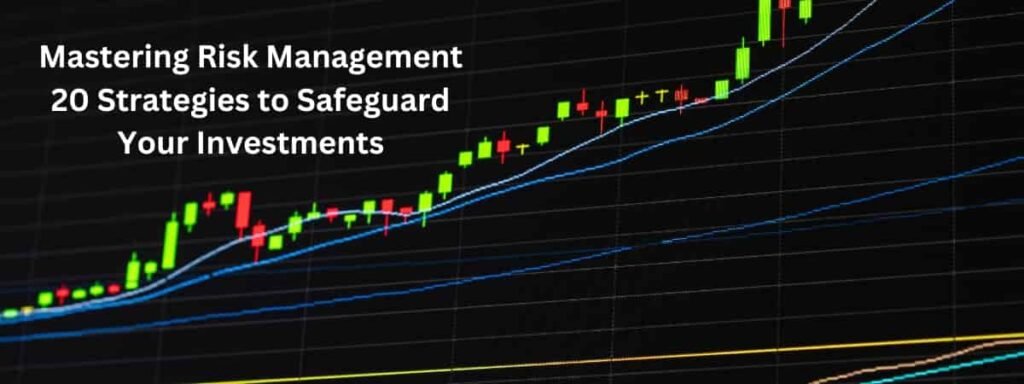
Introduction
The role of the stop-loss in risk management is huge, especially within markets of such a volatile nature. After all, stop-loss can be a powerful tool in any investor’s arsenal. This blog post will therefore define stop-loss, look at the feelings one has regarding risk in an investment strategy, and the purposes a stop-loss order has in properly managing risk concerning several examples.
Table of Contents
Importance of Risk Management in Investment Strategies
Risk management is the base for anything successful for an investment. Except for developing good practices of risk management that ensure the protection of capital the elimination of loss, and the enhancement of long-term returns, having a great one is highly imperative for survival in uncertainties, especially through volatile markets when price changes could be fast and variable.
Maintaining Discipline in Investment Strategies
The other critical benefit of stop-losses is that it has the capability of instilling discipline and a systematic approach to the strategies of any particular investment. The ability of stop-losses orders to bring about systematic management of the risks keeps investors with the pre-set level of risk and the attainment of their goals for investment. Stick to the stop-loss levels to remain focussed and don’t make on-the-spot losses following short-term market fluctuations.
Emotion-Free Decision Making
This masters the emotionless investment decision. In some cases, emotions like fear and greed nail judgment in an irrational decision. Stop-loss orders will help avert impulsive actions of investors due to emotions by automation of predetermined criteria for sell orders. This sort of disciplined approach helps ensure investment decisions should be rationally made and based on strategy, not sentiment.
Best Practices for Implementing Stop-Loss Orders
Stop-loss orders form an important part of the more revised plan for carrying forward the transactions, and effective risk management. In a position in which the risk management plans involve stop loss, it might enhance the ability to monitor and adjust stop levels, and even when necessary, integrate them into the diversification strategies of the portfolio, investors optimize their trading approach.

Incorporating Stop-Loss Orders in Risk Management Plans
Characterize Hazard Resilience: Build up clear chance resilience levels based on a person’s budgetary objectives and consolation with potential misfortunes.
Set Clear Targets: Decide the reason for each exchange or venture and adjust stop-loss orders with these targets to secure capital and oversee chance successfully.
Utilize Diverse Arrange Sorts: Investigate different stop-loss arrange sorts like standard stops, stop-limit orders, and trailing stops to tailor hazard administration methodologies to particular advertising conditions.
Observing and Altering Stop-Loss Levels
Customary Survey: Persistently screen advertises conditions, cost developments, and generally portfolio execution to guarantee that stop-loss levels stay pertinent and compelling.
Alter Deliberately: Be arranged to alter stop-loss levels based on changing showcase flow, instability, or modern data that will affect the venture proposition.
Maintain a strategic distance from Enthusiastic Choices: Make adjustments based on levelheaded investigation instead of passionate responses to short-term advertising fluctuations.
Coordination of Stop-Loss Orders with Portfolio Enhancement Techniques
- Expand Ventures: Combine stop-loss orders with a well-diversified portfolio to spread chance over distinctive resource classes and decrease presentation to person securities.
- Consider Relationships: Analyze relationships between resources within the portfolio to guarantee that stop-loss levels are set suitably to account for interconnected advertise developments.
- Audit Routinely: Occasionally audit the viability of stop-loss orders inside the setting of by and large portfolio expansion to preserve an adjusted risk-reward profile
- The sources offer profitable experiences into stop-loss orders, their benefits, disadvantages, and common cases. Here are a few key focuses from the sources
- Stop-Loss Orders: These orders are utilized to restrain misfortunes or bolt-in benefits on existing positions, making a difference in dealers overseeing hazards effectively.
- Benefits: Stop-loss orders are a savvy way to oversee the hazard of misfortune on an exchange, bolt in benefit, include teaching to exchanging endeavors, and expel feelings from exchanging decisions.
- Drawbacks: Price holes and getting halted out in choppy markets are potential disadvantages of stop-loss orders, particularly in volatile conditions.
- Methodologies: Dealers can moderate dangers by utilizing trailing stops, checking showcase conditions, and combining stop-loss orders with other hazard administration instruments like alternative contracts or enhancement strategies.
- Cases: Real-life cases outline how stop-loss orders can secure benefits, minimize misfortunes, and be used for drift exchanging, showcasing their viable application in completely different scenarios.
- Lessons Learned: Stop-loss orders can be profitable in unstable markets but require cautious thought of cost levels, showcase conditions, and the potential effect of sudden cost developments to optimize their viability.
Maintaining a strategic distance from Common Botches
Stop-loss orders ought to be utilized to oversee hazards, not foresee advertise developments. Dealers ought to not rely solely on stop-loss orders and disregard other components that can affect exchanging choices. It is basic to consider advertise instability, bolster and resistance levels, and specialized markers when setting stop-loss orders.
Checking on and Improve
Dealers ought to screen stop-loss orders frequently to guarantee they are still substantial and alter them as required based on changing showcase conditions. Being arranged to alter stop-loss levels as showcase elements change is vital to successfully oversee hazards and secure speculations
- Stop-Loss Orders: These orders are fundamental devices in exchanging and contributing that offer assistance oversee hazards by setting foreordained cost levels to restrain misfortunes or bolt-in profits.
- Benefits: Stop-loss orders offer assurance against potential misfortunes, give peace of intellect in unstable markets, include teaching to exchanging endeavors, and expel enthusiastic impacts from decision-making.
- Setting Stop-Loss Levels: Dealers ought to consider variables like chance resistance, security instability, and speculation objectives when deciding the cost level for a stop-loss order.
- Sorts of Orders: Different types of stop-loss orders, such as standard stops and trailing stops, cater to different exchanging methodologies and chance resistances, permitting adaptability in hazard management.
- Common Botches: Dealers ought to avoid relying exclusively on stop-loss orders to foresee showcase developments, eliminate these orders’ impediments in volatile markets, and utilize them in conjunction with other specialized markers and chance administration strategies.

Conclusion
In conclusion, Risk Management stop-loss orders play a vital part in chance administration by making a difference in dealers securing their speculations, overseeing misfortunes, and bolting benefits. Empowering perusers to execute stop-loss orders in their investment methodologies can significantly enhance their capacity to protect ventures in unstable markets. By understanding the significance of stop-loss orders, setting practical levels, and maintaining a strategic distance from common botches, speculators can explore the vulnerabilities of exchanging with more certainty and control.
This blog is for informational purposes only and should not be considered financial advice. Please consult a qualified financial advisor before making any investment decisions.
